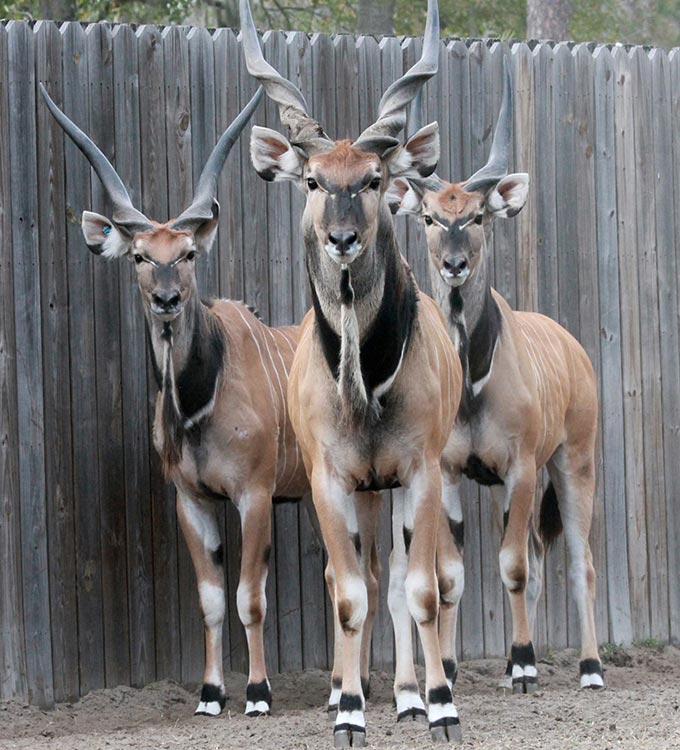“When we were considering what species to put in the Blesbok Exhibit, we learned from International Animal Exchange that Giant Eland may be available. We were a little concerned about breeding, and the large investment, but them we determined that an all-male exhibit was feasible, so we went for it. The exhibit turned out to be an Ultimate Ungulate exhibit, and our visitors and staff are awed by the magnificence of these animals. We are proud to be one of the zoos participating in the cooperative conservation and exhibit program for Giant Eland with International Animal Exchange.”
Eric Stephens – Director, Miami Metrozoo
“There are many species (Sumantran rhino, giant panda, mountain tapir) that I never thought I would see alive, let alone have the opportunity to work with in my long zoo career. The Giant Eland falls into that category as one of those elusive creatures that are truly magnificent and an exceptional display animal. Our partnership with International Animal Exchange on this made it possible.”
Mike Dee – General Curator, Los Angeles Zoo
“Our visitors and staff continues to be fulfilled and amazed with this Giant of African Antelopes! Giant Eland are a magnificent variant race of antelope, which has become highly endangered in recent years. Giant Eland are an ideal species as an educational model. Their true grace and beauty are unmatched in the antelope world. Any zoo that has the desire, space and support should participate in the Giant Eland Program! Thanks to International Animal Exchange for bringing these magnificent animals into the Captive Breeding Program.”
Randy Rieches – Curator of Animals, San Diego Zoo
“My experience with Giant Eland underscores the importance of establishing a viable captive population of a species before it becomes endangered in the wild. While the Giant Eland population was doing well when the first group was imported into the United States by International Animal Exchange, this species’ numbers in the wild have plummeted during the subsequent years of political upheaval and habitat loss. The financial investment made by all holders of Giant Eland has provided for a spirit of cooperation that ensures a healthy managed population.”
John Lukas – White Oak Conservation Center
“One of the delights of my life was the opportunity to have the Giant Antelope of Africa at the Cincinnati Zoo. I am so pleased at our successful breeding program. I recommend this species for all zoological exhibits and keeping with the future conservation programs.”
Ed Maruska – Director Emeritus 2003, Cincinnati Zoo
“Out of Africa and Deep into the Heart of Texas. I never dreamed I would be bringing one of the premier antelope species to Houston, my new home. When I learned that Giant Eland might be available, we found an exhibit and were ready to go. We had no budget to acquire the animals, but with the generous support of a donor who had a personal experience with Giant Eland in Africa, we now have this magnificent species in our collection. The all-male exhibit has impressed and entertained our 1.5 million zoo guests. The Giant Eland is truly a spectacular species! Our partnership with International Animal Exchange made this possible.”
Rick Barongi – Director, Houston Zoo
Giant Eland Natural History, Species Characteristics
The Giant Eland
Lord Derby’s Eland, also known as Giant Eland, were described by naturalist Gray in 1847 (Gray, 1847). Gray based his observations on skull and skin specimens collected by J. Whitfield in a expedition for the Earl of Derby to the River Gambia in west Africa. Today, Lord Derby’s Eland are now known as the nominate race, Taurotragus derbianus derbianus, of the species. Current research indicates that today the species is primarily indigenous only to Senegal and possibly Mali (East, 1989), augmented by an eastern race of Eland, Taurotragus d. gigas, indigenous to regions ranging from Cameroon to southern Sudan. The current captive population is originally from these geographic areas.
Very little is known of the Giant Eland’s natural habitat outside of casual observations by the hunters and researchers (Reade, 1865: Hillman, 1979). The species is understood to be a shy, difficult species to approach and observe, living in somewhat dry, bushveldt areas, and thought to be a nomadic browser species. Herds of 40 to 50 animals have been observed although their association to one another is not documented.
The first documented captive Giant Eland (Romo, 1994) were captured in Chad and transported to the Antwerp Zoo Europe in 1967. No Eland from this line remain.
The current North American population of giant Eland are descendants of a group of Eland imported by Brian Hunt, founder and CEO of International Animal Exchange Inc. (“IAE”), in 1986. The capture of those animals from the Central African Republic “CAR” was coordinated after a lengthy period of observation. The first tranche of Eland included nine Giant Eland that were quarantined in Bangui, CAR and finally, after much effort, to the U.S. These initial animals were placed at the Cincinnati Zoo and the Los Angeles Zoo. Their offspring are now at the African Safari Wildlife Park, Houston Zoo, Miami Metrozoo, San Diego Zoo, and the White Oak Conservation Center. As of November 2003, there were 70 Giant Eland.

